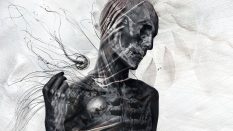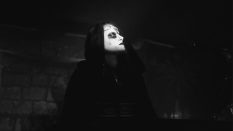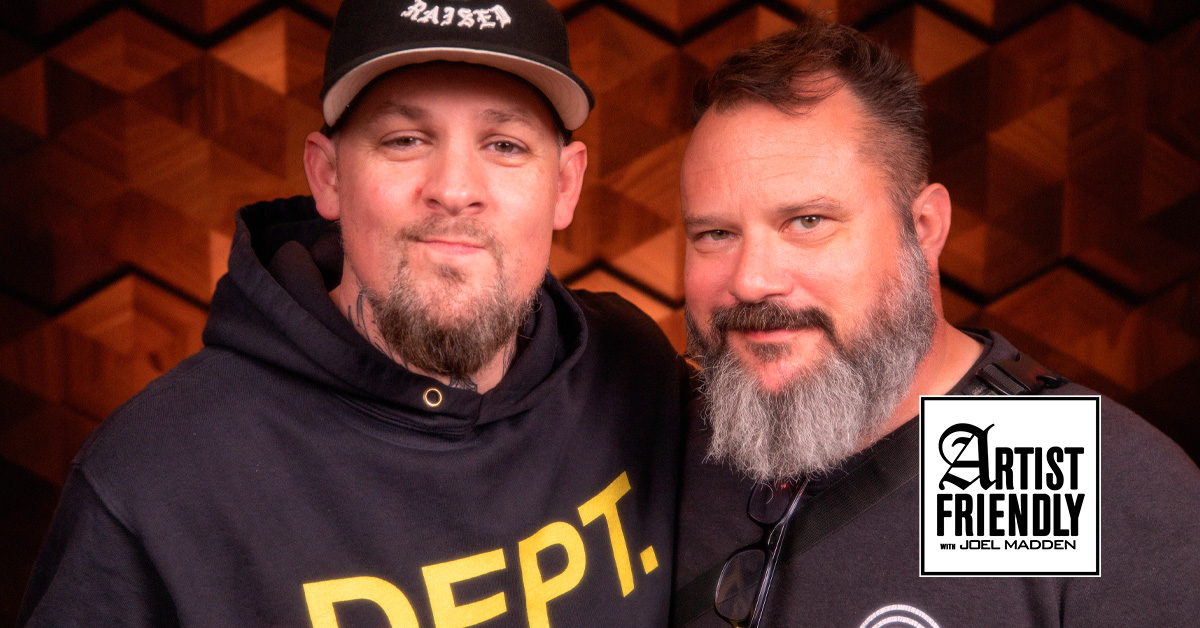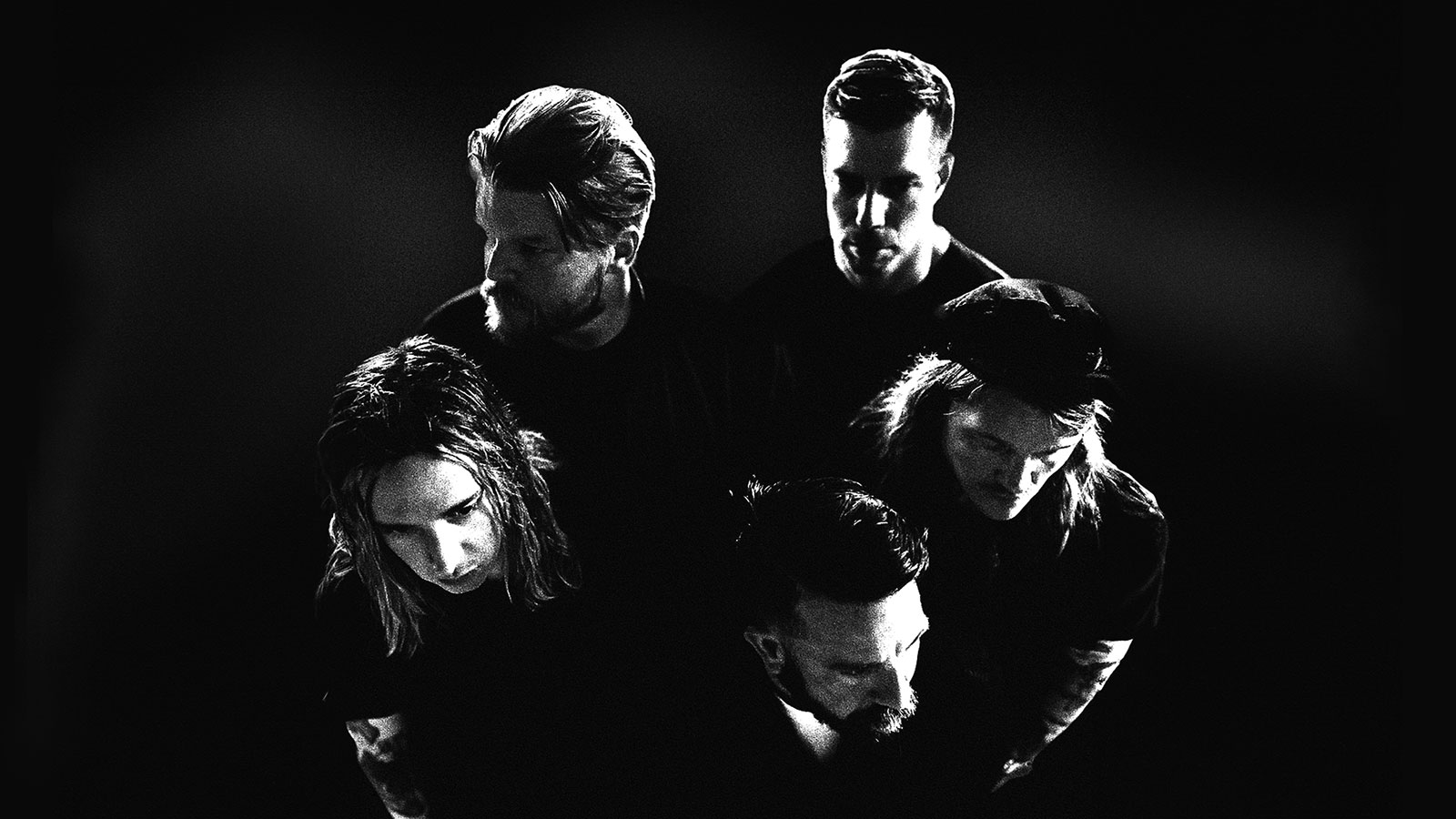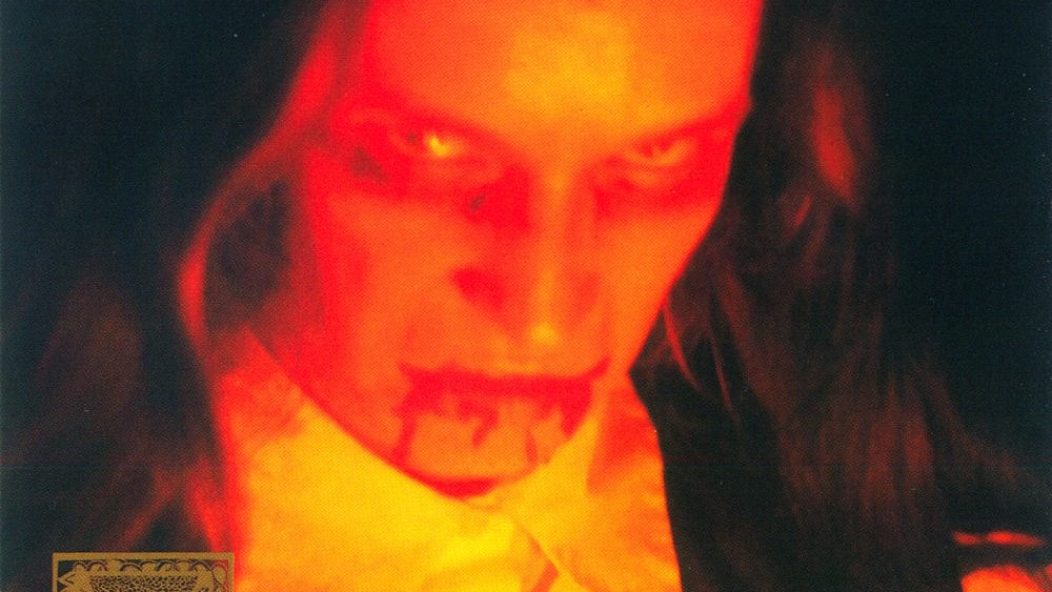
Haunted By Horror: A Conversation With Diabolical Masquerade
Though he is most known for his works as seminal doomed rock band Katatonia’s guitarist and songwriter, more lurks for Anders “Blakkheim” Nyström adherents in the shape of a four-album, horror-obsessed black metal project. Through his works as Diabolical Masquerade from 1993 to 2004, Blakkheim turned black metal on its head. While adhering to black metal’s most basic tenets, the progressive-minded Blakkheim, who was often joined by collaborator and eventual full bandmate Dan “The Spirits” Swanö (Edge of Sanity et al), saw fit to play games with the genre of music to which he was drawn.
Taking cues from progressive rock, heavy metal, and chamber music alike, Diabolical Masquerade’s approach to black metal was separate from their peers. Using dime-stop turns in style and capitalizing on the unexpected, this band’s black metal was (and still can be referred to as) “cutting edge.” The Nyström/Swanö duo led black metal — and metal itself — down many twists and turns, resulting in the style’s complete de-and-reconstruction.
Diabolical Masquerade’s progression from the more traditionally blackened (but still comical) Ravendusk in My Heart to the band’s final and most bizarre effort, the Death’s Design “soundtrack,” is a unique one. We tracked down Anders “Blakkheim” Nyström and Dan Swanö to tell the band’s entire story for the first time.
…
…
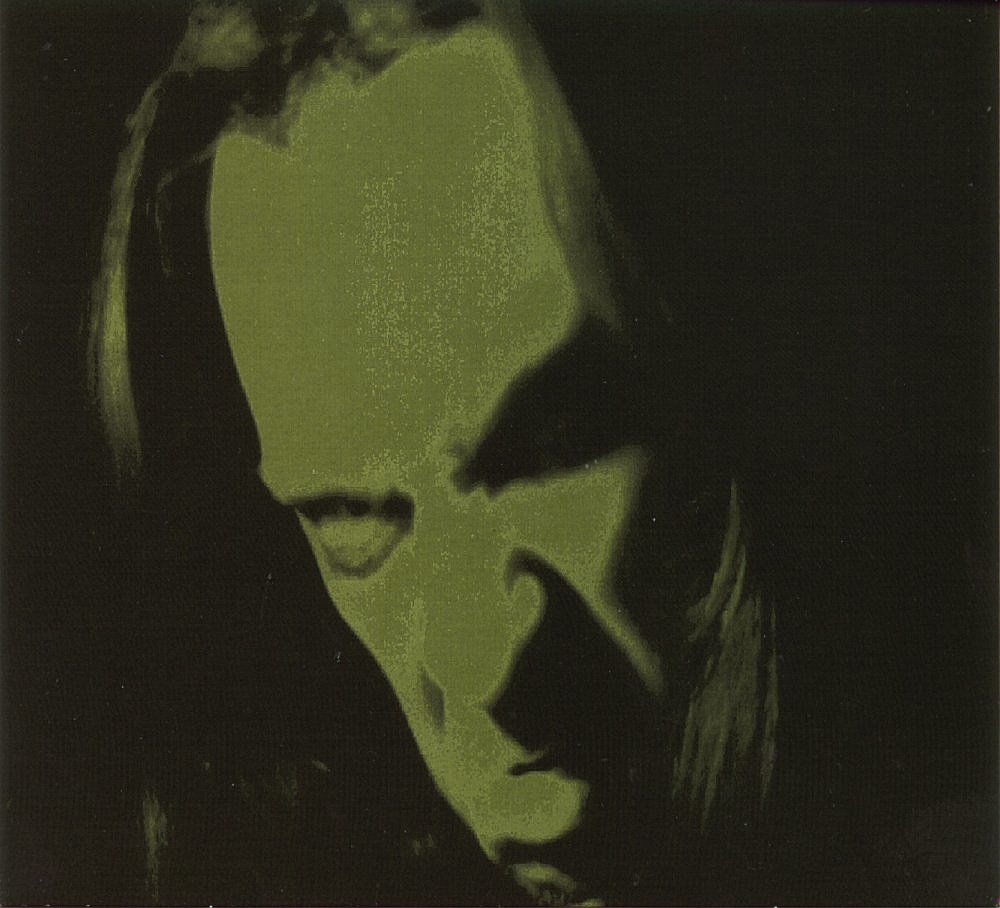
…
Interview with Anders “Blakkheim” Nyström
First off, and this is probably the question brewing in every Diabolical Masquerade fan’s mind: there have been rumors of a Diabolical Masquerade revival following the 2004 disbanding. Is there any validity to this? Is Diabolical Masquerade something you see yourself reviving at all at this point in your career?
Well, it certainly feels odd having to face a 20+ year gap in the discography, but at the same time, maybe that would bring more emphasis to the word “comeback”…? I don’t know… Can the ashes turn back into flames? Will the spirits abide me on a new journey? Is there any interest still lurking for this project out there?
What would a mature Diabolical Masquerade sound like in 2021?
I’m not sure Diabolical Masquerade has matured at all considering it has been lying dormant for the past two decades. When I ultimately abandoned the project a few years after Death’s Design, a ton of riffs and rough ideas were buried with it. So, should I ever venture down the crypts to summon Diabolical Masquerade, those musical scrolls could potentially still be conjured depending on the style that is relevant to conceptualize.
What first inspired you to make black metal?
Well, when we saw Katatonia naturally underway departing that style, I realized I was yet nowhere near done with it as a performing artist. So, the only logical step back then was to form a side-project and keep the range of opportunities ready within a new entity. That’s pretty much how things came about with Bloodbath as well. We formed it exclusively to represent an old school death metal style that Katatonia had touched upon even less, or hardly at all, to be honest.
Do you feel Diabolical Masquerade grew to be a foil for Katatonia’s then-new direction?
Diabolical Masquerade and Bloodbath have always been the counteracting alternatives to Katatonia. The objective was that where Katatonia will go, they cannot follow. Filling up the spectrum of metal music and placing a project in each corner of the ring has proven to be a successful integration between time and motivation. They all fight their own rounds.
What brought about Diabolical Masquerade’s unique sound? What first brought about this specific project?
In the beginning the idea was for Jonas Renkse (Katatonia) to be part of it as well and we were first going to use a Swedish spelling (Djävulsk Maskerad), but later opted for the English version. I actually remember Jonas drawing an early different logo for it back in 1993 when things were still floating in the daydream phase, but Jonas’s interest for black metal pretty much faded away over time, so the seasons turned it into a solo-project for myself. When I was writing the songs for the debut album, I wasn’t overly concerned about creating something unique or original, I guess I just wanted a piece of the pie from the ’90s black metal scene! To devotedly write and record black metal was probably my only desire and goal back in 1995 and I think the Norwegian black metal scene played a big role in fueling my passion to actually turn all this into reality. Having said that, without Bathory’s impact on my teen years, it’s safe to say that none of it would have happened in the first place.
How did you find yourself adapting your music style as you became a more technical player?
Well things got more intricate and everything branched out to finer details. For instance, on the debut I was playing mostly a lot of basic open power chords or one string tremolo riffing whereas on the last albums the riffs involved more palm muting, chord shapes with small dissonant coloring, finger picking and string skipping inside the chords. The keyboard themes got more complex and bigger. The rhythms and arrangements got more varied and progressive. At the end I’d hungrily open the floodgates to a ton more influences other than just black metal. I guess I never planned an album to sound a specific way except for the first album. The rest just happened as an answer to each stylistic change, pushed ahead by the will to explore new ground.
When you departed from the more traditionally-oriented Diabolical Masquerade sound and moved into more progressive, avant-garde territory, how do you feel zeroing in on these atypical aspects of music helped you grow as a musician and artist?
As a musician/guitar player, I definitely evolved more between 1995-2001 than I have between 2001-2021, but I think my writing has constantly grown in all kinds of mysterious ways. Sometimes, a step forward is making two steps back, sometimes you meet your former self in a weird 360 degree creative turn. It all comes down to the blend. One ingredient can change the entire recipe.
Diabolical Masquerade, especially in its earlier days, featured an alternate version of Blackheim, presented in an almost storybook fashion. Over time, this secondary persona was downplayed until it was eventually a mere factoid in the Diabolical Masquerade history. What was it like having this persona attached to you? As a more public artist with Katatonia, what was it like having an escape like “Blackheim”?
We chose to use pseudonyms when we started out with Katatonia to help establish the mystery of the band. As people had named themselves Quorthon, Euronymous, Cronos, and so on, that door was already unlocked for us. Blackheim was a character I could build and control by desire and I guess this was just the result of myself as a young adult having a last go at playing with my toys to make an escape from the mundane daily grind. I spent the majority of my days daydreaming, pondering and drifting off into parallel imaginary worlds. Back in my childhood I was heavily into role playing cardboard games, comics, phantasy books and RPG video games, so creating my alias Blackheim became my way of reconnecting with that former “child within” and extending all that lost creativity in a new shape and form: music and lyrics under the banner of metal.
What made you decide to present the Blackheim/Blakkheim character as something “larger than life,” especially on Ravendusk in my Heart?
Portraying myself as a fictional character in the lyrics just happened in the process of a subconscious ego boost. Being a one-man project, I didn’t have anyone to bounce ideas with, but that also meant there was nobody around to turn my ideas down. So, my free reign in creative control just ran wild! Eventually, this pending megalomania became a little too repetitive even for myself to deal with, so I decided to put an end to this narcissistic deviation for the second album.
…
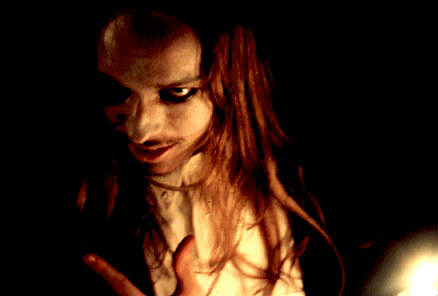
…
The project was known for its dime-stop stylistic changes and contrasting parts. Was being contrasting and featuring various musical influences an intentional part of your approach? Or was it more natural than that?
Yeah, the contrasting factor was always the motivation to evolve, surprise and entertain. I always viewed Diabolical Masquerade’s musical playground to be like a huge scrap yard filled with weird things to “Frankenstein” into new creations. I treated the songs as separate cars in a roller coaster train, going in and out of control.
When pivoting from a gothic aesthetic to something more modern-film-and-film score-inspired for Death’s Design, how did your musicianship have to adapt? Did one change before the other?
Well, right back at the start I was firmly heading into a traditional black metal style tied to an ancient pagan and phantasy theme. It was epic and melodic, but still rather streamlined. Then, gradually by each album that followed, I saw myself turn more and more into a progressive and technical black metal style with a lot more diversity and finesse and experimentation. Also, the aesthetics, atmosphere and lyrical themes shifted from phantasy more into horror/occult and culminated with something very modern yet supernatural. If something was musically out of my skill, I always had Swanö and the guests to contribute with their musicianship and raise the bar.
Was Death’s Design actually a film? What made you want to make a film score?
The short and blunt answer is no, but I guess we all want the long answer? Ok, the whole thing started as an experiment, but developed more and more into some kind of “artsy scam”… A lot of people have figured that out by now, but this is the first time I officially admit that nothing was real.
After Nightwork I’d grown completely obsessed with the thought of making a “dummy” film score, and if there was no movie, I had to pretend there was one! This got the ball rolling off the map… I wanted people to experience it like a real thing, so I had to work the authenticity level up to the point where nobody would be able to tell right from wrong (this was still very early in the internet age).
So, the first thing I made up was a fictional American film company called “West & Hill” which I thought had just enough corporate flair of the movie industry. We claimed that they owned the rights to the shelved movie and our label had negotiated with them to grant us the license to release the soundtrack independently.
Then we “hired” a quartet from Estonia which would correspond correctly to the credit of all the orchestral samples used on the album. I even researched for typical Baltic male names to get the musicians credits somewhat legit. I asked my designer Travis Smith to come up with art and images to look as if they were stills and excerpts from the film and put together the layout in a typical soundtrack style. I also split the track listing into all these weird creative “movements” representing the timeline of the script. In fact, I more or less wrote a movie script getting all those segments in place and I also remember the movie “Final Destination” inspired the album title.
We were filling the blanks with details that looked pretty convincing, but still couldn’t be verified, so far so good. Then while talking to the media at the time of the release, I just kept a poker face and emphasized how lucky we were to get the soundtrack released and most journos either believed it or even played along, feeding the illusion ha-ha! Now when I look back on the whole spectacle, it surely raised some eyebrows! An idea far outside the box, undeniably original and entertaining, but with a big commercial risk. My label could easily have declined it all, but showed some faith and turned it into a cult release.
…
…
Do you keep up with current black metal at all? When creating your vision of black metal during Diabolical Masquerade’s period of activity, could you imagine the genre’s current widespread popularity?
I’ve completely lost track of today’s black metal scene. I still regularly visit the classic 80/90s black metal albums I keep in my collection, but some, or even most of those bands aren’t around anymore. The only new black metal album I’ve been listening to a lot and enjoyed in the last couple of years is Craft’s White Noise and Black Metal.
Did you ever envision Diabolical Masquerade having the cult following it currently does? How did you envision the project’s future?
Well, it was fun while it lasted, that’s for sure! Regarding the future, I don’t know if there is one? Hey future, if you see this, call me!
Peaceville has steadily been reissuing your catalog on CD and vinyl over the past six or so years. Has this process led to you revisiting your older music?
Yes, I recently listened through all the records, one after another, to refresh my memory and see how they are holding up after all these years. I also made a poll to help find out which album was sitting the best with the fans and it turns out Nightwork has taken a huge lead on that front, followed by Ravendusk In My Heart, Death’s Design, and The Phantom Lodge in that order.
What has the process of revisiting these albums like?
Nostalgic, entertaining, impressive and embarrassing all at once!
Have you found any new inspiration in your old material?
I appreciate all of them for what they are, but my heart always yearned a little stronger for Nightwork.
When Dan Swanö was officially invited into the band as a full member for the final album, what was it like fully inviting someone into your private world? Was it different than writing with Katatonia?
Swanö was more or less my co-pilot during the whole run of the discography and we had a blast! Not only did he mix all four albums, but he also performed on all of them and at the end he was co-writing and co-producing as well. Let me break it down in a timeline album by album and reveal the facts, so either stop reading or brace yourself for the truth…
1995: I sent out a one-track demo (The Castle Of Blackheim) to the French label Adipocere Records who offers me a two album deal. After all the songs for the debut Ravendusk In My Heart were written, I headed down to Unisound Studio in Örebro. Swanö assisted in programming all the drums and keyboards, and also rips it up with some so called “German heavy metal” guest vocals. There are no other guests on this album other than the Spirit’s unearthly presence.
1996: When all the songs for The Phantom Lodge were completed I returned to the tower of Unisound in Örebro. This time we decided to mix programmed and real drums to lose some of the static touch the debut was suffering from. We programmed mainly the beats and left the fills (mostly toms) played by Swanö on a real kit. So, if you ever looked at the credits and wondered what was up with this guy called “Sean C. Bates” supposedly playing the drums, it’s just one of many more aliases for Dan Swanö. Reading through the rest of the credits, I can see that I also featured a couple of session guest musicians on this album, or wait a second… Did I really? The credits incline that “Tina Sahlstedt” and “Marie Gaard Engberg” were two flute playing women, but they were obviously witty names to disguise a keyboard. “Ingmar Döhn” was supposed to be an old teacher from my music class doing a bass solo, but that was Swanö again having a go. “Roger Öberg” doing “pagan screams” was just an old friend hanging out.
1998: I had like 2-3 minutes of each track ready, but couldn’t manage finishing the whole album in time for the date of the studio booking. So, I brought what I’d done so far down to The Sanctuary, which was the name of Swanö’s new studio located at the basement floor at the “Iron Square” in Örebro (Unisound used to be at the top floor). We arranged the remainder of the songs simultaneously as we recorded on the spot. Swanö was now for the first time sitting behind a real drum kit for the entirety of the album. He also came up with some of the amazing keyboard themes that we used as an opposite songwriting approach where guitars are backing up the keyboards and not vice versa. We had a tremendous workflow piecing together the entire recording under two weeks!
So, let’s take a look at the credits for this one. Former bass-solo virtuoso “Ingmar Döhn” insists he’s now moved on from just playing bass lines to cello! Yeah right! It also seems like “Marie Gaard Engberg” didn’t feel the need to bring her lady friend for the flute performances, but decided she could pull it off herself this time. Was it a Ménage à trois gone wrong? Only Ingmar knows… ha-ha!
2000: Swanö got rid of his studio and started to work at a music store so he was just able to record part time, from home. We had some chats about the future, whether I should go ahead and do a fourth album, and Swanö made it clear he wanted to be involved right from the start. This suits my vision of the soundtrack perfectly, so we decided to take it to a next level experiment and the dummy soundtrack idea re-launched our motivation like rockets! I went down with my skeletons of ideas and we set up in his living room. I recorded all my riffs again to programmed drums or click tracks, adding all the orchestral samples, FX, and keyboards, and then Swanö arranged everything into what would become the “movements.” A few weeks later, I returned to record all my vocals while standing inside a hallway closet (poor neighbours!).
Ok, diving into the credits this time around. Of course good ol’ “Ingmar Döhn” is back again, but this time he claims to have conducted the orchestra, but not by himself, he’s actually done it with a character called “Lembit Metzig” (which was an Estonian pimp in a TV-series). “Sean C. Bates” is obviously given a second chance behind the kit since the drums are back to being programmed. “Aag” who is playing guest solos is Dan Swanö’s older brother Dag Swanö (aka Tom Nouga). “Patrik Selsfors” is a jazz player that Swanö invited for extra diversity. Then we have “The Maalten Quartet” from Estonia, featuring “Artieer Garsnek,” “Jaak Gunst,” “Heiki Schmolski,” “Elmo Meltz,” and “Konstantin Uweholst.” Oh and I almost forgot the piano player “Jaari Fleger,” who was exclusively signed to “Oktan Records” at the time, so with their kind permission (thanks again!) we’re able to feature him on the album as well ha-ha! And last but not least, none of this would have been possible, if it wasn’t because of the directors (I had names for them as well that I don’t remember now) at the “West & Hill Corporation” who blessed the project and granted us the rights. Do you now believe all the crazy fun me and Swanö had cooking this up? If I offended or let anyone down by revealing all the above, I’m NOT sorry, cheerz!
Does Bloodbath fulfill the same needs for you that Diabolical Masquerade did?
From an extreme metal point of view, yeah, I’d say it pretty much covers it, but if we take a deep dive into characteristics of the black metal genre and the subsequent “magic” defined therein, there’s of course a distant void that can only be filled by a project like Diabolical Masquerade.
Are there any stories about Diabolical Masquerade which you would like to share?
Well, I got one going back again to the Death’s Design album that I found pretty hilarious. When we incorporated all these orchestral samples taken from the sampler library, little did we know that an American TV-show called “Fear Factor” also ended up using the same samples for some of their early episodes, but of course without the guitars, drums, and vocals. Apparently, this still deceived people into thinking Diabolical Masquerade got featured on that show and nobody could really grasp what the hell was going on ha-ha! Kinda like getting busted, but still getting away with it!
I also got another story from when we were recording The Phantom Lodge. Each night me and my friend kept hearing strange sounds coming from the opposite side of a wall. Nothing strange about that, except that there was supposed to be no room on that other side. I took it as a sign of the spirits unearthly presence and this influenced the last song on the album that I renamed “Upon The Salty Wall Of The Broody Gargoyle.” I kept telling Swanö about it each morning and I think he got a little spooked out about it. Later on, when Unisound was closed down and Swanö moved out, he found out there was a blind spot room behind that wall, used as a laundry room or something, what an anticlimax to pop the ghost bubble ha-ha!
A question from a friend: is there an intentional reference to the X-Files (Season 5, Episode 7 at 35:05) in “Death’s Design – 3rd Movement”?
Ha-ha well it seems “Fear Factor” wasn’t the only TV-show getting their hands on those orchestral samples…
Is there anything else you would like to share about Diabolical Masquerade?
Well, CD reissues of all four albums are due for release this year and, better late than never, we finally got a full merch line going now at the store for the first time ever, so check that out!
What do you feel Diabolical Masquerade’s legacy is?
To wear, or not wear the masque, that is the question…
…
…
Interview with Dan Swanö
Generally speaking, when people think of Diabolical Masquerade, they think of Anders, but you have been an integral part of that project from day one. I’m interested in your perspective as a “behind the scenes” character for that band.
I kind of weaseled my way in gradually from doing really what I had been doing forever, really. I did a lot of one-man, sometimes duos, and then I fleshed it out. For me it started already back in the day when I did stuff with Godsend, which is just one guy showing up from Norway. I did the drums, the keyboards, the vocals, the mixing, the recording, everything. All he did was come up with a bunch of riffs and play guitar and bass. So, already then I liked that. It was refreshing, you know? Ultimately Katatonia showed up for the first time. I helped them out a lot adding guitars on their first demos and a lot of keyboards. Anders knew I was up for more than just doing the engineering bit. On the first record I did all the drum programming, some keyboards, and some heavy metal screams or whatever. By the next album, my input was kind of the same, but I think I actually recorded the toms, but everything else was programmed. I gradually found my way into the program, but I was always like an outlying kind of character that took more and more space. It was never like I told Anders to back off and let me do whatever I want. He just allowed me to take more space, and that was always nice.
I think about your gradual moving into the band before you were credited as a full member on Death’s Design. What was it like being credited as a full member?
I never saw it that way, but it made sense since I did so much. It was almost like Anders came to me with a bunch of riff ideas and I was really just getting into “all in the box” computer recording and mixing at the time. I was fascinated by this “cut, copy, and paste” and how you can alter arrangements stuff so easily. When the drums are MIDI like on that record and everything else was just straight to the computer and you could take that little middle bit of a riff and cut and paste it eight times, you end up with a new riff. I wanted to explore that kind of creation, but it was really hard to write normal rock songs in that way. Doing something that was not completely off what we did with Crimson was to have a lot of bits and pieces and just put together something and stretch every bit into what it is. That was the most interesting part of Death’s Design was Anders was there and he did a click track, he set the tempo, and he just recorded his guitars and I think bass, also. And then he left! I was just messing around with that for I don’t know how long because I didn’t work as a studio engineer anymore. I had a full time job and worked on this in my spare time. I told him, “Yeah I’m ready now! It turned your little seed into a full-grown fucking tree! Now you just have to come do some vocals on top, and then I will mix and master it and then it will be ready!”
For him it was a luxury thing, and he was doing other stuff with Katatonia, but he wanted to do another Diabolical Masquerade. Since I was unavailable for doing it for two weeks straight, that was it. That was it or he had to go somewhere else. I think we had gone so far with Nightwork and all that, how good we can work together, and I don’t think he wanted to start from scratch with someone else.
…
…
As things were getting more progressively progressive and experimental, especially with this cut and paste method, how did you adapt over the years?
I dreamt about doing that to audio from the first time I worked with Cubase in 1991. The guitar player in Unicorn showed up in the rehearsal room one day, saying they’d bought a computer. “He did what!? Okay! What do you do with a computer?” You record with keyboards in the computer and the synchronizer box which you put on the recording studio for one track. But it meant that rather than recording the keyboards on cassette in the recording studio, they could “fly in the air” with this Cubase and the Atari 1040 computer. AS soon as I saw you could play a bit and copy and paste what you did — you don’t have to play for a minute! you only play for ten seconds and copy it eight times. “Oh wow!” You could do the same thing with drums or record that perfect take on a guitar riff or acoustic guitar, that would be the best thing ever! That was kind of almost happening in the biggest of biggest things in the early incarnations of some kind of sonics solution system. I know Nirvana did some bits like that, but it took like an hour to render 20 seconds of audio! It was really old school. But you can copy that perfect bit for a longer duration with crossfades and stuff, but it was really really old school. When I bought my first digital workstation in 1995 or 1996, I think: a Roland VS880. You could copy and paste, but you had to do it in an old school like… you push a button for the start, the ending, and where you want it to go, and then execute it. That was when you were not working on a grid or whatever. You got really professional after a bit. I know that we recorded Nightwork all digital, using only the eight tracks on that Roland machine and then everything else was in MIDI, that was later “flown into” the music in the digital domain-ish. That was also based on Anders recording a riff and then I would bam bam bam execute, and it was copied eight times. He was like “wow, that’s cool!” That’s how we did that one.
Then I thought: once this shit gets visual I would have the best time ever. That happened a little bit later, maybe 1998 or 1999 I could do something like that with Infestdead — I recorded it on an Apple G3 computer using Cubase VST32 — and I actually just copied and pasted a full record. I did a lot of that stuff where I took the first bit of a riff, cut it in half, turned it backwards and all this weird shit that people did in the early times.So many bands did so many weird things the first moment you could manipulate audio like that. Plugins kind of existed, but you could do so much with mangling stuff. I used it more as a very very flexible multitrack recorder because It was so fast. You didn’t have to do shit in real time like you could do maybe with an ADAT recorder or, a little bit later, the digital Sony machines, but you could “fly” parts like a chorus or a second chorus, but it was all in real time and complicated. Now it was so quick. I think that Death’s Design was the first time I really took that to another level of really doing a full-on production from the ground up, really. I fully saw the potential of “in the box” and I’ve been there ever since.
This idea of finding perfection through finding the best take and copying and pasting it a bunch of times is interesting, especially when you mangle it and take the perfection and put it on its head, which is a great way of describing Diabolical Masquerade through its precision and oddity. Were you looking to do something that odd with this, or was it just something which came from your creativity?
I think it became a bit weirder than I thought as a whole, but when you listen to each fragment from the soundtrack, it really is that. It’s like a Crimson-style album that wasn’t linked into one big cohesive piece, which is not really easy to do with a metronome and a pulse. Crimson from Edge of Sanity was recorded without a click track and evolved tempo-wise. It kind of gets to where the next riff needs to be, but once you start programming strange tempo rises or falling, it’s easy to stay in that BPM and stop to make a fragment one minute or so. It’s a soundtrack, so why not?
As a whole I think it is a tough one for people who expect more of a song-based thing like we had done in the previous three albums. That was also something that we did. It was a weird thing, but once we were doing each little bit of music, each piece felt straightforward and not complex, but the presentation was unusual and strange.
With the progression of the music, I was curious as to what goals you had for each album and how the band changed to accommodate those goals?
The first one was, for me, just Anders showing up and “okay, I want to make a solo thing,” that he talked about with this Blackheim character. That was it! I didn’t know there would be a second one, but I thought it was pretty cool for him to do The Phantom Lodge. I remember he had a friend with him because he didn’t really feel like being alone when I went home. He had a friend there. He was not contributing in any musical way, but he was hanging out, he was a presence. They rented movies and had all kinds of weird ideas with the lyrics and the concept. I was still kind of doing my traditional thing but I was hired as a session drummer and keyboarder. I don’t remember writing anything at all for The Phantom Lodge. Maybe one little thing… not really. It was pretty much realizing Anders’ songs.
For Nightwork, I feel like we were functioning more as a duo where I was more than just “that guy who would record and mix it.” The drums were all performed except for the kick drums, which was terrible but had to be done. I had no possibility to rectify any of my mistakes as we recorded to tape. That was pretty nasty.
I would ask Anders if he had any ideas. “I have this riff or that riff.” Okay! We repeat those twice, and now we’re at 3:12. Then I started playing something on my brand new, pretty cool keyboard with orchestral sounds. Everything I played: “That sounds cool!” and we would record it to the Atari and then work out a guitar part to go around it. It’s pretty easy to figure out what I wrote and what Anders wrote on Nightwork. If it’s not based on keyboards, it’s something Anders wrote, but when there is this orchestral [singing] kind of part, that’s my part. That’s kind of where that whole thing for the sound was born. I could just flesh out stuff he wrote with some underlying keyboard themes, or I could write the riff itself on the keyboard and he’d be some background thing on guitar and bass. That dynamic was interesting because it kept the songs interesting since it came from two writers all the time. I don’t really remember playing guitar, not even for writing. That was not my thing, he would do the guitar stuff. At that point we felt it was more of a collaboration from the songwriting up. I could actually produce the album in a way I couldn’t with the first two becauseI didn’t feel I had the authority to say a riff was boring or comment on repetition. I saw it as a normal day of work. But with Nightwork, I took time off my day job — all of May, I guess, in 1998 — to do Nightwork and record Moontower. I gave him, like, ten days or two weeks of my life, full-time, and I needed something more out of that than just being the hired gun to do the recording again. It all worked out, he enjoyed this, and he only had larger fragments than Death’s Design, or they could have been songs if you would have thrown a boring solo passage and then repeated some other shit… they would have been four-minute metal songs, but we wanted to take it beyond that. That’s what we did with Nightwork, it has a very special aura.
I was actually listening to “Rider on the Bonez” before we messaged each other.
[Laughs] That’s cool! I found the original mixes on a DAT tape. When I was bringing all my old stuff from Sweden to Germany, I found some old cassettes, a lot of DAT tapes. A lot of them had no markings on it, but I knew from the brand of tapes from which era, and those were those purple HHB tapes. “ah, that must be something from The sAnctuary!” and it was the unmastered version of Nightwork. I don’t know what they did in the mastering in 1998, but it could have been part of the loudness war with not that great of equipment. So, it’s there. I think I sent it to Anders: full dynamic, before anyone messed with it. So I listened to that during the transfer… It’s a pretty cool record.
That’s awesome! I wonder what sort of audio work can be done with that source audio.
Normally you don’t really need any mastering! That was just something you needed because you needed it. You don’t really know why. Of course, you can’t do it the same as you do now: sending a DDP master link to Poland or Austria and boom! You have a CD. You had to transfer it to something called pneumatic video tape. I went and visited the Black Mark headquarters and took home some Edge of Sanity master tapes. They look like this weird VHS type thing, which was then the format you sent to the factory. So then, of course, you had to go to a mastering facility because nobody owned the pneumatic video… they were super expensive, and you needed some kind of software to encode stuff. It was pretty complicated up until the DDP or you can send a CDr. I would gladly re-release it the way it sounds, because to me full dynamic without any mastering sounds better unless there was really a monitoring issue like too much bass or no bass at al. That could be rectified at the mastering, but I really like the idea of going back to the original mix without any tweaks. Like Unanimated’s Ancient God of Evil reissue is done from the raw DAT mix. It was never mastered, that’s why it sounds so good!
With Death’s Design, Anders told me a story about what you had planned for the album conceptually. The fake American movie company, the various fake people who were keyboard patches. What was it like coming up with all those ideas?
Ah, it was the best time! We were laughing our fucking brains out, it was so hilarious. We thought we’d get away with it because these CD-ROM royalty-free samples that I got from this Yamaha sampler I bought at the time… they would just… people would believe it’s a real orchestra! So we’d “go to Estonia” and there was this bassist. I know what the guy looks like, I have him in my head! This Ingmar Döhn, we made him up! He was like a music teacher and he’d have this brown kind of tweed looking… he looked a bit 1970s in the 1990s, which was super out at the time. He’d have not that much hair and he’d have the bass pretty high up, a Fender jazz bass. He’d be interested in this old jazz stuff. We totally invented him and Sean C. Bates, kind of a Sean Reinert guy who was a jazz fusion guy who also did metal. There was a person playing flute… we had all these internal stories.
When Anders got going with the storytelling and how we invented all this weird shit. It was this bubble during this time, and it was really super fun, actually. Sometimes we scared the shit out of each other with this vocal effect I found, which was this strange sort of resonator effect which changed the pitch of the human voice. It’s called a ring modulator. We turned something nice you say and turned it into some diabolical, demonic weird shit because it modulates the fundament of your voice, pitching one part up and another down. We were like “wow, this sounds so evil!” We’d get chills and start looking over our shoulder in search of this weird demon. I remember this vividly, it was actually a great time.
There was always this air of mystery surrounding that album. Does the film exist, et cetera.
[Laughs]
It’s really cool getting this validation that there was a concept beyond the album, it just was… fun. It’s always nice to hear that artists have fun creating something. I always feel black metal is so serious, and this was not.
I don’t think Diabolical Masquerade was ever serious in that sense. I don’t even remember any friction or anything really, any arguments. We just did what we did! It was a really fun time and then you have someone pay for you to do it, which was even better. And then, fuck, this is going to come out on CD? People are going to hear this! I still have the poster somewhere, which looks like a movie poster. Travis Smith took the typing from movie posters.It was really cool. We were really selling the whole thing for a long time. I don’t know when Anders started telling the truth about it. I didn’t want to go into any detail because I don’t want to do damage to a vibe he wants for an album. I respect that and simply shut up, not giving anything away. If it’s a CD-ROM featuring an Estonian orchestra, then it is!
Looking back on all of this Diabolical Masquerade business. Four albums, lots of music. What do you feel the band’s legacy is now?
I can’t fully take credit for it,because I got the idea from other bands, but this thing with an orchestra plus black metal-ish metal… It’s been done a lot after Death’s Design, and I have heard some rumors that there are some very influential people in the genre still at it today who still love Death’s Design. I like to think we were one of the pioneers in that style, and that was fucking cool! I love it. I remember the first time I heard those samples you can still hear to this day on the Discovery Channel. “Ooh, a shark is coming!” and then you hear the music from Death’s Design [laughs]. When I loaded that sample bank into the sampler, and pushed the keyboard and heard [vocalizes a rhythm]. It’s a metal riff! Another key? [vocalizes discordance]. All these weird sound effects! All I did was press one key, then another later, and you had a riff! It was a whole keyboard filled with orchestral phrases. I was in heaven because sonically they sounded great! Big, fat stereo recordings and easy to work with because I didn’t have to adapt any riffs to put an orchestra on it. No! Let’s put a metal band on this orchestra! and that was it! It sounded super pro, but it was super easy.
The legacy is from Death’s Design. What we did with the first three albums… I don’t really know. At least once a year someone says “Oh Diabolical Masquerade! I love Nightwork! It’s inspiring!” And that’s cool! It’s one of the cooler projects I was involved with as far as playing and later writing. Probably the top 20 from my entire career of stuff that gets name dropped.
It’s funny that you bring up the Discovery Channel sample, as I asked Anders about a sample found in an “X-Files” episode.
It’s a strange feeling, the first time I heard that on TV. The album was a couple of years old. I got really, like, “What the fuck! I hope nobody gets this connection!” We had to deliver the orchestra separately for publishing reasons, which bands do today. They give the stems, or an instrumental, to place in a commercial which never happens. Nobody knew! I saw all the “X-Files” episodes, so I probably heard it there, too. But I remember the shark thing, especially. It’s played back on the Diabolical Masquerade album without any effects. It’s possible I stole something from the Discovery Channel and put it on an album!
…
The Diabolical Masquerade collection is available from Peaceville Records.
Diabolical Masquerade merchandise can be found at their official shop.
…




